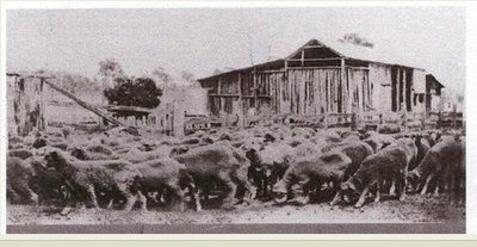WESTERN AUSTRALIA SHEEP VENTURE
PREPARATION
1867 Mar 14 Lambton Mount filed with The Colonial Secretary and application asking for a Grant of £750 from the WA Gov. to survey a route from Ling George Sound W.A to Adelaide to erect a telegraph line to the two states. Gordon was in Adelaide asking the SA Gov for a similar Grant after successful completion (Border Watch (Mount Gambier, SA Thursday 13 January 1938, pa1866 Nov. Went into partnership with Lambton Mount & John Peakes. To Transport sheep to Western Australia.
1866 Nov. Maggie stayed with John Riddoch at Yallum Park.
1866 Nov 17 Left Williamstown in partnership with Lambton Mount & John Peakes. To Transport sheep to Western Australia. (The Argus Melbourne Monday 17 September 1866) Just prior to that, Gordon visited the Opera in Melbourne and composed his poem “The Old Leaven” (Bunbury Herald Friday 9 March 1928, page 1)
1866 Nov. 20 The Speaker of SA Parliament reported receiving a letter from Mr. A.L. Gordon ,
resigning his seat as a representative of the District of Victoria. Hansard Page 997.
1866 Nov 24 Fytte 8 of “Ye Wearie Wayfarer” appeared in” Bell’s Life” 24/11/66
1866 Dec 11 Landed at Bunbury W.A with Lambton Mount and 4000 Merinos and 800 Leicester sheep. “Age” 11/8/66 (sic)
Lambton’s brothers Frank and Julius are also said to have been with the £12,000 venture (File My Father Lambton Le Breton Mount)
1866 Dec 26 Lambton Mount wrote to the Colonial Secretary asking that the 65,000 acres that they had taken up be rent free for some time.
(Border Watch (Mount Gambier, SA Thursday 13 January 1938, page 6)
1866 Dec 29 “Craedat Judaeus Appella” appeared in “Bell’s Life” 29/12/66
1866 Dec 29 The Champion Winner appeared. “Australasian” 29/12/66.
1867 Jan 19 “Frusha,” after introduced into “Ashtaroth,” as “Thora’s Song” appeared. “Australasian” 19/1/67
1867 Mar. Rode from Manjimup to Albany W.A to return to Adelaide S.A. Left Lambton behind to manage sheep.
1867 Mar 14 Lambton Mount filed with The Colonial Secretary and application asking for a Grant of £750 from the WA Gov. to survey a route from King George Sound W.A to Adelaide to erect a telegraph line to the two states. Gordon was in Adelaide asking the SA Gov for a similar Grant after successful completion (Border Watch (Mount Gambier, SA Thursday 13 January 1938, pa
Gave up Glenelg residence and went back to Mount Gambier. “Sladen Humphris xxx1” “Humphris” Page 108
Reproducing a biography by Eileen Kaye first published in The Australasian Newspaper in serial form in 1933.
This series of articles was recovered from The Australasian newspaper by Travis M. Sellers.
Edited by John W. Adams, with permission kindly given by The State Library of Victoria.
Gordon failed to appear at the South Australian Parliament Roll Call on October 26th 1866 and the next month he resigned.
Gordon looked about him and hesitated about settling in Western Australia but an occupation is what he badly needed, both for financial reasons and for his mental balance.
Ever since the arrival of the disturbing inheritance, over five years ago, when he had given up his former active life, he had felt the need for a definite job. Since it was now proved beyond question that politics were not his forte, he must find some more suitable career.
Within a matter of a few weeks he paid a visit to Ballarat, the Victorian steeplechasing centre, but could see no prospects there. He sent some more sporting verses to the papers. He went across to Melbourne and met up with an acquaintance, Lambton Mount whilst managing a visit to the opera which was the inspiration for his poem “The Old Leaven”. This poem was anonymously published in The Australasian on Saturday 10th November 1866, page 5, prior to his departure.
His wife, Maggie, who was by then pregnant, stayed with John Riddoch at Yallum Park.
Lambton Le Breton Mount (1836-1931) was a Canadian-born Australian businessman. He is credited with introducing the sport of lacrosse to Australia. He was also a champion amateur athlete, known as “The Canadian Stag”.
Previously in 1864 Lambton had gone exploring and sheep farming into the unfavourable Pilbra region of North-West Australia with his brother Frank. He returned within two years leaving his brother to manage the properties that they had established there.
Adam Lindsay Gordon, upon meeting Lambton Mount, went into a partnership with him to farm sheep in the South-West of Western Australia, but owing to drought and poison weed they lost over it.
WILLIAMSTOWN VICTORIA – WATCH ON YOUTUBE

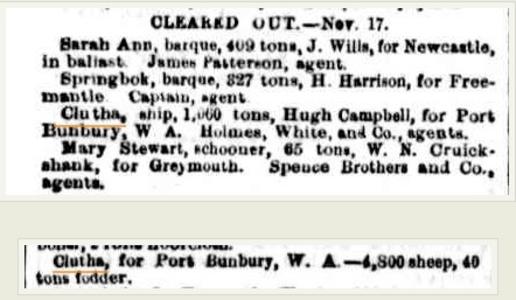
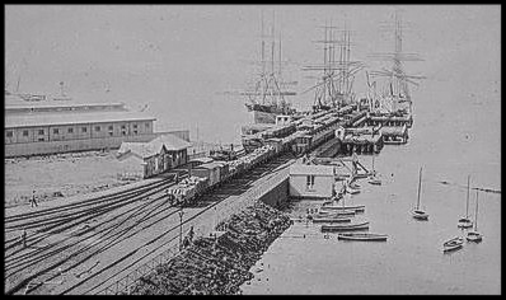
GELIBRAND PIER
The Gellibrand Railway Pier was constructed between 1854 and 1859 by the Melbourne Mount Alexander and Murray River Railway Company. The first stage of the work, undertaken by contractors Musson and Bourne, involved the construction of a solid embankment, some 244 metres long, into the bay, part of which is now covered by the approaches of the existing pier. In 1857 contractors Evans Merry & Co built a 183 metre timber extension. The original two major wings on each side of the Pier were altered and extended until their removal sometime between the early 1880s and 1894. The Pier was remodelled and extended in 1963 to take tankers. From Victorian Heritage.
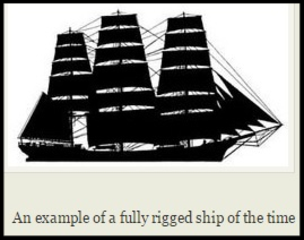
The ship Clutha of 1060 tons was built in the Quebec shipping yards in 1855 by William Russell. The owners were Potter and Company for the Port of Glasgow. It was wrecked in September 1871 off the Island of Anticosti -Mouth of St.Lawrence River Canada.
It was classed as “A1” for hull and stores.
It was 186 feet long, 35.6 feet wide and 22 feet deep
(Ref: Record of Canadian Shipping by Frederick William Wallace https://archive.org/details/recordofcanadianOOwall
Google Books “Lloyds Register of British and Foreign Shipping 1860-1861” p138)
ARRIVING AT BUNBURY WESTERN AUSTRALIA
BUNBURY WESTERN AUSTRALIA – WATCH ON YOUTUBE
It is interesting to note that Captain Campbell, on making his ship’s entry into the Bunbury port records, reported that, when arriving with his cargo of sheep, there was no light to guide his ship to Bunbury at 1am when 12 miles from the Port.
Also an absence of facilities for the ship to water except for a neglected water-hole some distance from the jetty
and that there was no boat belonging to the Port.

Before the Clutha left Williamstown, an advertisement in the Perth papers by Captain Campbell appeared which resulted in a cargo of 91 horses being shipped from Bunbury to India (Calcutta or Madras).
It was noted that the horses were the finest that the colony could supply.
The ship provided a spacious stable on-board 20 feet high as there was very little cargo.
(The Inquirer Perth 23 January 1867 Page 3)
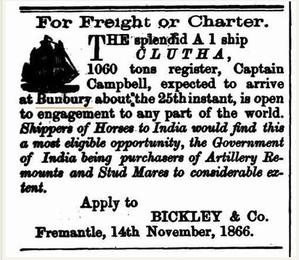
BUNBURY JETTY WATCH ON YOUTUBE
The first Bunbury jetty was built by William Forrest, beginning in 1864 with convict labour sent from Fremantle. A supervised gang would travel from the Fremantle Gaol to Bunbury.
It was 1400 feet long into seven feet of water. An extension continued in 1865 with William Spencer who also built the Wellington Hotel.
The jetty was not completed until 1868, which would explain the method of unloading sheep from the Clutha by swimming them to shore.
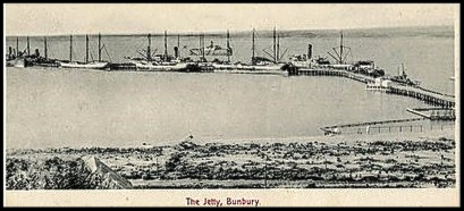
Gordon and Lambton Mount (also a Mr. John Peakes, who many years resided near Northam) left Williamstown, Victoria,
They arrived in Bunbury on December 6 or 11, 1866, and landed the sheep on the beach, mostly by swimming them ashore; and the
weaker ones were taken in the ship’s boats. The Merino sheep were in poor condition , and many were lost. The Leicesters were, however, in good condition and stood the journey well.
The arrival of such a large flock in Bunbury was an event of great interest to the townspeople and especially to the bigger children, many of whom were eager to assist in minding the flock on the sand hills about the town. Gordon was good to these children and rewarded their services. One resident of the seaport town treasured a shilling which the poet had given him — the first shilling he had ever earned — and also recalls Gordon’s kindness to him when he was knocked down in the drafting yard. The events which immediately followed the landing and subsequent shepherding of the flock on the more fertile lands about Picton are best described by Miss May Thomson, now of Bridgetown.

“Gordon and my father,” she says, “were in the same set in England, fond of hunting and sport; their nicknames in the hunting field were ‘Mucker Gordon’ and ‘Tally Ho Thomson’. Gordon was called ‘Mucker’ because he rode ‘amok’ at any sort of fence or brook and generally managed to get over.
One day, I think about the end of ’66, my father rode in to Bunbury to the monthly board meeting from our home at Brookhampton, and put up at the old Wellington Hotel as usual, (the Ted Spencers kept it then). That evening Mrs Spencer came to my father in some distress and told him that two men called Mount and Gordon were there who seemed quite gentlemen, but were in drovers’ clothes, and a ‘flash’ commercial traveller was there who objected to sitting down to table with them; and as they kept only two tables in those days, she did not like putting them in the kitchen.
So Father went in to the room, and of course he and Gordon recognised each other. Father said, “Why, it’s ‘Mucker!” and he, “Tally Ho!” They were delighted to meet as neither expected to see the
THE WELLINGTON HOTEL – NOW TRAFALGAR’S – 36 VICTORIA STREET BUNBURY

In 1857, William Batts (or Bass) applied for a licence for the ‘Swan Inn’. William Spencer took over the licence in 1862. As it is recorded that Clara Spencer (later Lady James Mitchell) was born at the Wellington Hotel in 1864, it is possible that the Swan Inn became the Wellington Hotel about this time. A licence was issued to Ashford and Spencer for the Wellington Hotel in 1865.
The Wellington Hotel was the centre of social and community life in Bunbury until the Mechanics Institute was built in 1867. Reports state that the dining room was used for Agricultural Show dinners, dances and many other gatherings. William Spencer held the licence during this time. A photograph dated 1870 shows the Wellington Hotel as a two storey building rendered building with regularly placed widows (9 small panes 3×3) with shutters, and a shingle roof.
http://inherit.stateheritage.wa.gov.au/Public/Inventory/Details/38293056-8a7e-4599-8de2-e87fd88e6de3
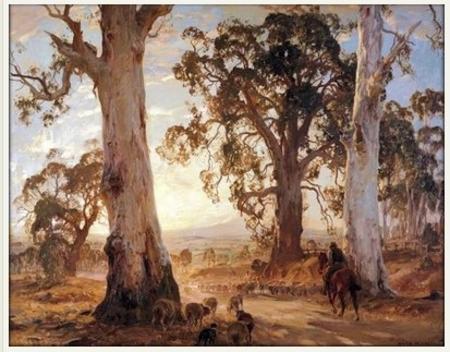


My father James Guy Thomson brought Gordon out to stay with us at Brookhampton and they ran their sheep on our run for about three weeks. Gordon was very fond of hunting and liked going out on the run with father and the stock boys.
He always asked for an outlaw to ride. One of them started bucking in some thick black-boys one day, but he was quite unconcerned — it never moved him. Miss Thomson, although a very young child, remembers him at their home. She states that he was tall and handsome, with a very pleasant manner.
James Guy Thomson was known for his breeding of horses for export to India.
They had several kangaroo hunts, while the party were camped upon the spot that is now occupied by the Public Hall of that South Western Township.

Brookhampton was one of the first homesteads in the district and is associated with James Guy Thompson, and, by his two marriages, the Roe and Bussell families.
Thomson was a prominent figure in the district and for many years the homestead was the social centre of the district.
Although the extensive nature of the original homestead is no longer legible, due to a fire in the 1970’s the three remaining buildings are very good examples of small Victorian Georgian buildings and the construction methods using hand-made bricks fired on site illustrate the resourceful building techniques of the early settlers.
In the 1850s, a squatter named Mueller, which was anglicised to Miller, erected a slab hut on land that was taken up in 1858 -9, as freehold and extensive pastoral leases, by:-
James Guy Thomson (b. Oxfordshire, 1833; arr. 1855, d. 1890;
m. 1856 , Emma, d. 1876, daughter of Surveyor General J. S. Roe;
m. 2nd 1878, Mary Elizabeth ‘Bessie’ Bussell).
Until mid-1858, Thomson was in partnership with S. P. Phillips and A. Lee Steere, as Phillips and Co., graziers and horse-breeders, at Toodyay.
He continued these pursuits at the place he named ‘Brookhampton’ after a family home in England. (Editor: Brookhampton is in Oxford-Hence the confusion that ALG went to Oxford.)
He was the first permanent settler in the district that took its name from his farm and pastoral station.
In early 1860, he took his wife and family from Bunbury to visit the place, and the slab hut and kitchen became the nucleus of their home with the linear addition of three new rooms by May 1861, when they took up residence.
At various periods in 1863- 79, he employed a number of ticket-of – leave men, including carpenters and bricklayers, who probably worked on erecting some of the buildings and structures.
There were numerous other outbuildings.
In 1882, two separate fires destroyed the hayshed and the carpenter’s shop.
During Thomson’s lifetime notable visitors who stayed for an extended period included his friend the poet Adam Lindsay Gordon and the botanist Dr. Ferdinand Von Mueller (later knighted, 1879), who collected flora in the surrounding district.
In 1890, James Guy Thomson (snr) died.
ARRIVING BLACKWOOD VALLEY BALINGUP
BALINGUP BROOK
Negotiations were subsequently entered into by Gordon for the purchase of a pastoral lease on House’s or Padbury’s brook, near Balingup, and the sheep were moved to this run and shepherded. A number of men were employed by Gordon, and great activity followed. They erected from thirty to forty miles of “dog fence,” made several large paddocks and kept the sheep in them. The dingoes were very troublesome, and it was necessary to yard the flock each night. If any of the sheep were left out
they were always missing next morning. This necessitated the engaging of several shepherds, and the chief shepherd was Mr Albert Blythe, of Bunbury.
Albert Blythe’s brother mentions that Albert had to split the sheep into three flocks and he moved Mr.Gordon’s sheep out the back.
By this time there was considerable settlement in this part of the colony, and Gordon became known to many of the old pioneers, who found him a man after their own hearts.
Because of the hardships encountered at Balingup it was decided to move the sheep a further 40 miles south east to the Donnelly River
just outside the township of Manjimup.


Ferndale, one of the earliest homesteads in the Shire of Donnybrook-Balingup, was built in 1859, by William May for Walter Padbury (b. 1820, arr. 1830, d. 1907), the first European settler to take up land in the Balingup district, namely Location 8 (Ferndale) in 1859, and Location 3 in 1860. James Forrest, father of Sir John Forrest, set out the Victorian Georgian style homestead constructed of mud bricks, with jarrah floors and a shingled roof. To accommodate workers, a ‘humpy’, a single roomed dwelling, with a fireplace was also constructed of similar materials.
Walter Padbury, who was orphaned shortly after his arrival at the Swan River Colony, rose from working as a shepherd to become one of the most successful entrepreneurs in the Colony and was renowned for his philanthropy. He established his brothers, Mark (b. 1822) and Edwin (b. 1811), at Ferndale and (nearby) Brooklands respectively to manage his large holdings in the district. From 1859, Mark resided at Ferndale with his wife, Louisa, and later with his second wife, Charlotte (m. Nov. 1860). Ferndale was initially used mainly for cattle grazing, with some land under tillage. In 1868-1869, large flocks of sheep were introduced. Mark died in 1886, and, in 1887, Walter Padbury sold Ferndale to William Byers Wood, of Bunbury, for £400, who continued to use it for pastoral purposes.
(http://inherit.stateheritage.wa.gov.au/Public/Inventory/Details/7d90a572-3b41-4a94-b20b-b3659d31446b)
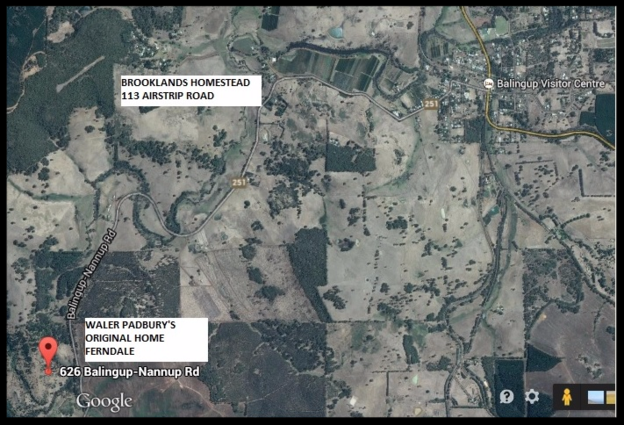

ANOTHER ACCOUNT
Meanwhile the sheep under Mount’s control were first shepherded on Mr. Thomson’s run, until a leasehold of 50,000 acres on the Upper Balingup was secured. Here Mount erected a comfortable camp, which has long, since given place to a later settler’s home. While he remained at Brookhampton, Gordon used to ride over to Mount’s, but he does not seem to have lived there. It is not possible, to state the year that Mount abandoned this area and trekked to the Donnelly. But his occupation could not have been short, as he is known to have erected some 30 miles of fencing, and his name appears in the Brookhampton accounts in 1868.
ARRIVING AT DONNELLY RIVER MANJIMUP
POISON WEED
Sunday Times (Perth) 17 June 1917 p3:
Some 13 miles out from Manjimup we came to the “Bridge House”, the property of Mrs de Winton Randall, which is famous from the fact that the poet Adam Lindsay Gordon once stayed there several months.
It was originally built by Mr. Lambton Mount , one of the old Ballarat family, who was in partnership with Gordon. They secured a large area and proposed to establish a sheep station, and the poet on one of a number of trips to Western Australia took down a number of sheep to the place, where he remained for some little time.
The surrounding bush was unsuitable for Gordon’s horse riding habits.
It is said that the lining of the old jarrah hut was covered with sketches and scribbling, and it is most probable that Gordon put many of his thoughts on that unique parchment, which was later pulled down and probably burnt.
Mrs Randall is building a new cottage nearby, but Western Australia should take some steps to preserve the slab hut where Gordon no doubt wrote some of his poems.

Western Mail (Perth, WA) 23 Aug 1934 p8:
“GORDON’S COTTAGE.” (Photo Shown Above)
To the Editor.
Sir,-In recent correspondence in “The Western Mail” about the home of Lindsay Gordon in the West, and the photograph that appeared, supposedly taken at Harvey, is a photograph of the cottage on my property on the Donnelly River, where Lindsay Gordon stopped some time with his uncle, (sic) who was running sheep there. The centre portion of this photograph is the old original cottage, which had a shingle roof, which was replaced by galvanised iron.
Yours etc., G. V.
CLIMBING THE DIAMOND TREE WATCH ON YOUTUBE

Gordon sent Mount over to the Donnelly River Valley. Purchased 20 hectares (50 acres) of land on the East Bank. They became the first settlers in the valley. Gordon then leased 20,000 hectares of the surrounding country known as Mt Lewen Station .
This part of the country was infested with blind grass (Lobelia). The particularly severe and wet winter which followed considerably
added to their misfortunes till only 1,300 sheep could be mustered.
From a financial point of view the sheep farming venture was a complete failure; all the capital invested was lost.
Though it is not generally known, prior to leaving Western Australia, Gordon requested Mr. Mount to destroy, without reading, a whole portmanteau full of manuscript. One poem alone seemed to have escaped, and that was found by a shepherd in the pocket of an old pair of trousers, given him by Mount after Gordon had left.
It was incomplete, unrevised, and in places the manuscript was indistinct.
Commencing: “All night I’ve heard the marsh frog’s croak,” It described an incident when mustering scrub cattle, which were plentiful in the district at that time.
He has been remembered in the Manjimup area in the names of roads and forest plants. Lambton Mount is remembered in the South West more than Adam Lindsay Gordon.
Discouraged and dispirited Gordon decided to return to the Eastern States in March 1867. He rode overland to Albany, and embarked there for the Eastern States.
Albert Blythe was foreman for Mr L. L. Mount. After Mr Mount left there he sold the property to the Giblett family and they named it Mount Lewin, and the same property was then called Graphite.
It is believed that Lambton Mount returned to his property at Ballinup before selling up and leaving in 1869.
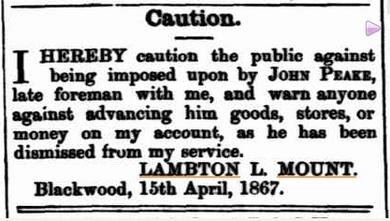
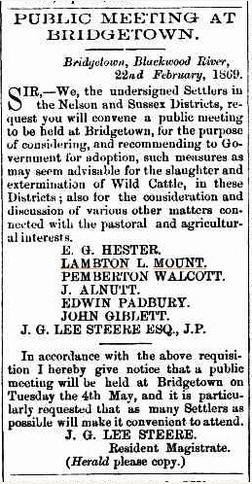
The Herald (Fremantle) 6 Nov 1869 p3:
For Sale or to Let. A RUN of 30,000 acres on the Donelly River, Nelson District, including 15 miles frontage of both sides, of the River, which is a strong running stream all the year round.
The Homestead comprises 60 acres in fee simple, and a paddock of 1,100 acres, securely fenced with a very substantial and Sheep-proof, new mahogany four-rail fence.
A Kitchen garden of 2 acres in good cultivation, half an acre of vineyard, two commodious huts, substantial stockyards, and every convenience for carrying on either a large cattle or horse station, the country being most luxuriantly grassed and well watered.
There are also 40,000 bricks; 35,006 feet sawn timber, assorted sizes ; 45,000 shingles; 4,000 slabs; 3,000 palings ; 1,000 pieces of fencing; 6,000 laths; and various other timber suitable for a fine dwelling.
The Homestead is situated on the River 24 miles from Bridgetown, from which there is a good road, and about 65 miles from the Vasse by the Warren Road.
Any communication addressed to the undersigned at Bunbury, will receive prompt attention. LAMBTON L. MOUNT.
PURE MERINO SHEEP. Imported from Victoria. T0 be sold by Public Auction at the Bunbury Show on the 24th Nov.:- if not previously disposed of by private Sale-about 600 Merino Ewes 6 and 8 tooth; and 47 Rams 6 and 8 tooth.
Also about 500 lambs dropped in June last, 100 of which have been retained as Ram lambs.
Any communication addressed to the undersigned at Bunbury will receive prompt attention. LAMBTON L. MOUNT.
